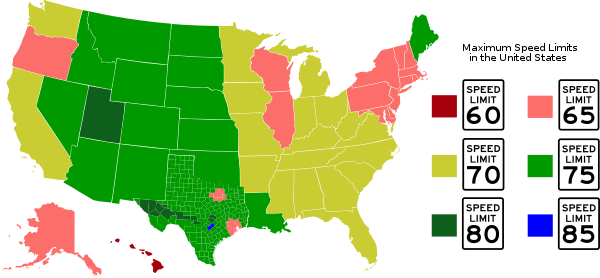Speed limits in the United States are set by each state or territory. Speed limits in the United States vary according to the type of road and land use. Increments of five miles per hour are used. Additionally, these limits sometimes differ according to the type of vehicle and the time of day. Occasionally there are also minimum speed limits.
Most speed limits are set by the legislatures of states and territories as law statutes. States generally allow a statewide transportation agency and lesser authorities to change speed limits.
For approximately thirteen years (1974–1987), no speed limit in the United States exceeded 55 mph (89 km/h). Prior to that, speed limits were mostly the same as today, but more often higher or nonexistent in rural areas. Montana and Nevada among others previously had no statutory speed limits for cars and motorcycles in certain conditions.
The highest speed limits are usually found in the inland West, and the lowest limits are usually found in the Northeast. Some limits fall outside these ranges. For example, some two-lane rural roads inTexas have 75 mph (121 km/h) speed limits, and there are two stretches of Interstate Highway in Texas with a daytime 80 mph (129 km/h) speed limit for passenger vehicles, as well as two stretches in Utah with 80 mph limits being tested as of January 2009. In contrast, the highest speed limit on freeways in Hawaii is 60 mph (97 km/h).







